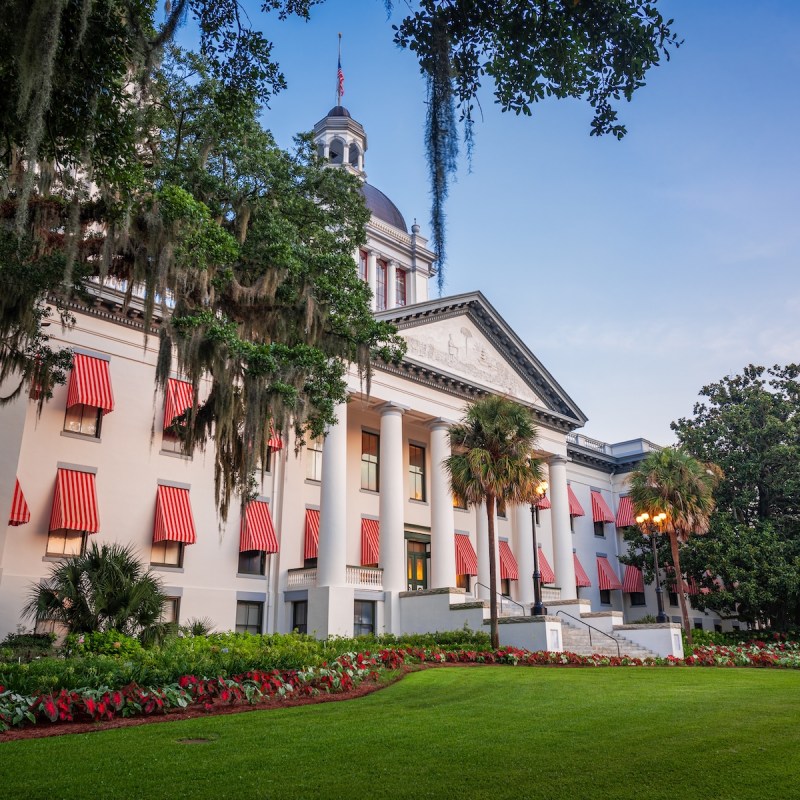
With an abundance of sunny days and temperatures hovering around 70 degrees, Florida’s capital city is an ideal place to visit as a chill sets in around other parts of the country. Aside from balmy weather, Tallahassee has a wealth of green spaces, fascinating museums, and with Florida State University and Florida A&M University, there is never a lack of unique events and activities to experience.
Videos by TravelAwaits
I attended Florida State University many years ago. Back then, school was my main focus, but as someone who has loved to travel her whole life, even as an undergraduate, I carved out time between classes to explore Tallahassee and the surrounding areas.
I have relished returning to Tallahassee over the years to visit college friends and continue exploring now that I don’t have to hit the books. These are the places I always find myself visiting again and again when I’m in town.

1. Tallahassee Museum
There is no better place to get an education about the natural and human history of Tallahassee than the Tallahassee Museum. The museum is situated on 52 acres outside of town and most of the exhibits are outdoors, because who wants to be inside on a beautiful north Florida day?
Being an animal lover, my favorite exhibit is Wildlife Florida, where a variety of native mammals, reptiles, and birds that are unable to live in the wild spend their days in large enclosures that mimic their natural habitats. An elevated boardwalk affords you views of black bears, bobcats, and the endangered Florida panther. Other exhibits include Old Florida, where you can explore a historic schoolhouse and Baptist church, learn about the daily lives of Tallahassee’s early settlers at Big Bend Farm, and immerse yourself in nature along the half-mile trail leading through a longleaf pine forest.
Since much of the museum is outdoors, be prepared with bug spray, sunscreen, and comfortable shoes. The boardwalks are wheelchair accessible. Keeping with the natural theme, there is little pavement and most of the grounds are covered with thick mulch.

2. Canopy Roads
For a scenic drive like none other, take a tour along one or all of Tallahassee’s canopy roads. Canopy roads are defined by the towering native trees that cover the road like sweet gums, hickory trees, and live oaks draped in spindly Spanish moss. Nine official canopy roads now branch out from Tallahassee, covering 78 miles of pavement.
The roads offer a quiet, peaceful drive and a glimpse into Tallahassee’s past. Prior to being paved, the roads were well-traveled paths used over the centuries by Native Americans and white settlers of the area.
If you only have time to drive one road, choose Centerville Road/Moccasin Gap Road and include a stop at Bradley’s Country Store. This Tallahassee landmark opened in 1927 and is still run today by third- and fourth-generation members of the Bradley family. Pick up a bag of grits milled on-site and a package of their smoked sausage, a local favorite.

3. Alfred B. Maclay Gardens State Park
Tallahassee has more parks than you can count, from the mountain bike trails and disc golf courses of the expansive Tom Brown Park to the pavilions and shops around Lake Ella. Still, the park I find myself always returning to is the serene and historic Alfred B. Maclay Gardens State Park.
New Yorkers Alfred and Louise Maclay fell in love with Tallahassee on a visit in the early 1920s. They went about making it their winter home and planted these lush gardens. Visitors today can stroll the gardens of brightly-colored camellias, azaleas, and rhododendrons.
Pick up a map of the self-guided walking tour of the gardens at the ranger station. You can also tour the 1909 Maclay House during the high-blooming season from January through April. Wheelchairs and golf carts are available with advance notice.
Venture beyond the gardens to explore the rest of this 28-acre park. Walk or bike the many trails and look for great-horned owls hiding in tree branches and alligators resting in the waters of Lake Hall.
4. Lake Jackson Mounds Archeological State Park
A brief 15-minute drive from the gardens takes you back centuries to the time of the first human residents of Tallahassee. Lake Jackson Mounds Archeological State Park is home to six earthen temple mounds created by early people, for what is believed to be ceremonial purposes, from 1100–1500 AD.
Two of the mounds are available for public viewing and can be seen not far from the parking area, or you can climb the short set of stairs to the observation deck for a birds-eye view. The largest mound is 278 feet by 312 feet at the base and stands 36 feet high. Two trails wind through the rest of the park if you wish to explore further. You can also request a ranger-guided tour of the park with a 2-week notice.

5. Railroad Square
Tallahassee has always been a city that prides itself on fostering the art scene, so it’s a given that an entire section of town would be devoted to celebrating local artisans. Railroad Square is one of four locations within Tallahassee’s Art District. The other three locations are Railroad Village, Railroad Crossing, and the Art District Collective. Each section has its own vibe and is worth a visit.
Railroad Square is the best place to start your exploration of The Art District. This former 1940s warehouse park has been transformed into a collection of art galleries, diverse restaurants, and small, locally-owned businesses. Support local artists at South of Soho Cooperative Art Gallery. Savor the unique flavors of Africa at Halisi Afro-fusion Boutique and Café. You can even relive those carefree days spent in the arcade at Flippin’ Great Pinball.
6. Tallahassee-St. Marks Trail Historic Railroad State Trail
An amazing way to explore the natural beauty of the Apalachicola National Forest surrounding Tallahassee is to take a bike ride along the Tallahassee-St. Marks Trail Historic Railroad State Trail. The trail follows a once-thriving railway line starting near Capital Circle in Tallahassee and leading 16 miles south to the lovely town of St. Marks on the coast of Apalachee Bay.
The wide-paved trail is perfect for bikes, but all modes of non-motorized transportation are welcome, as well as leashed dogs. Several benches are located along the trail as well as a few restrooms and vaulted toilets. Bring your own bike or rent one at The Great Bicycle Shop. Be aware that you will be responsible for transporting bikes to the trailhead.
If you plan a round-trip tour, take some time to explore St. Marks and fuel up for the way back with a heaping basket of crispy fried shrimp at Riverside Café. Enjoy your shrimp while taking in views of the lazy St. Marks River.

7. St. Marks National Wildlife Refuge
There are a few side trips that can’t be missed during a visit to Tallahassee. One of those trips is a visit to St. Marks National Wildlife Refuge, about a 30-minute drive south of Tallahassee. The refuge is located along 43 miles of the Gulf Coast and features a wealth of diverse habitats from tidal flats and palm hammocks to wetlands, all of which are home to staggering populations of animal and plant life.
Take a drive on Lighthouse Road to best explore the refuge. The road runs 6.5 miles from the visitor center to the iconic St. Marks Lighthouse, the oldest lighthouse on the Gulf Coast. Stop along the road to look for white ibises stalking the mud flats and bald eagles soaring above the palm trees. Listen for the deep bellow of bull alligators.
8. Edward Ball Wakulla Springs State Park
Edward Ball Wakulla Springs State Park combines nature and history, which makes it another can’t-miss side-trip. The park offers the chance to explore the largest and deepest freshwater springs in the world and stay in the historic Lodge at Wakulla Springs.
The Mediterranean-style lodge was built in the 1930s by industrialist Edward Ball. The interior of the hotel is beautifully decorated with ceiling beams featuring intricate tile mosaics hovering over dark wood floors. The rooms are tastefully decorated with period furniture and each room offers a view of the springs.
Behind the lodge, the famous springs sparkle in the sun before dissolving into the deep cypress forest. A wide lawn offers the perfect place to relax and dry off after an invigorating dip in the cold water.
To really explore the springs, book a spot on the jungle cruise boat tour. The open-air boat takes you down the Wakulla River. Your captain will tell you about the natural history of the springs while keeping an eye out for wildlife, like bulbous manatees floating just under the surface by the boat and massive alligators sunning on the banks.
Pro Tip: Hotel prices can double or even triple and the crowds get crazy when Florida State has a home football game. Check FSU’s schedule if you plan on visiting in the fall and wish to avoid those weekends.
For more things to do on Florida’s Gulf Coast, check out these articles:
